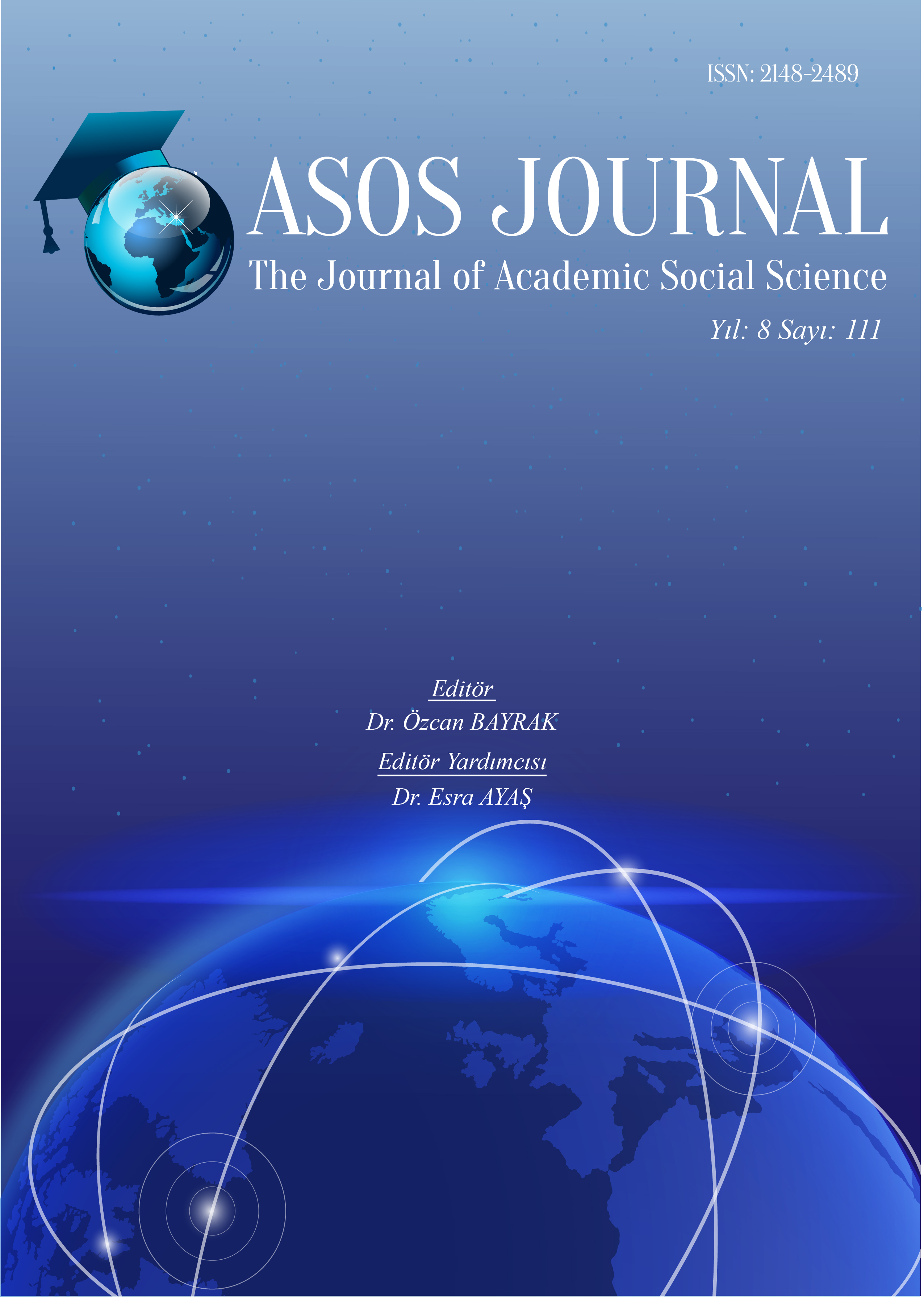Author :
Abstract
Istabl-ı âmireye bağlı olan raht hazinesi, enderun hazinesinin fonlarından biridir. Raht hazinesinin bürokratik işlerinden Istabl-ı Âmire Teşkilâtının yöneticisi olan Mirâhûr-ı evvel sorumluydu. Has ahıra bağlı olan raht hazinesinde, bayramlarda, sefere gidiş ve dönüşlerde, düğün ve mevlid kandili gibi önemli günlerde padişaha hediye edilen eyer ve raht takımları muhafaza edilirdi. Raht hazinesinde yer alan bu eşyalar sanat değeri açısından yüksek, altın ve gümüş işçiliği ile titizlikle yapılmış ve elmas, inci, zümrüt, yakut, zeberced, pirûze gibi değerli taşlarla süslenmiştir. Raht hazinesi, hazinedar değişikliği halinde devir teslimi yapıldığında, eskiyen raht takımlarını tespit etmek üzere ve padişaha layık olan raht takımlarını seçebilmek maksadıyla raht hazinesinde bulunan eşyaların yoklaması yapılırdı. Hepsi birer sanat eseri olan bu raht takımları raht hazinesi yoklama defterlerine katipler tarafından kayıt edilmiştir.
Keywords
Abstract
The Royal Saddle Treasury under the Royal Stable Administration is one of the funds of the Inner Treasury. Mirâhûr-ı evvel (first supervisor of the royal stables), who was also the manager of the Royal Saddle Treasury, was responsible for the bureaucratic transactions of the Royal Stable Administration. Saddles and saddle sets presented to the Sultan in holidays, when setting off or coming back from campaigns, weddings or in important days such as holy birthday of the Prophet were kept in the Royal Stables organized under the palace stables. Such objects contained in the Royal Stables Treasury have been created with goldsmith or silversmith workmanship of high artistic value and ornamented with valuable stones such as diamonds, pearls, emeralds, rubies or turquoise. Objects in the Royal Stables Treasury were reviewed to determine the worn saddle sets and select the saddles sets good enough to be used by the Sultan during the handing over process to the new Treasurer in case of a change of the treasurer. These saddle sets, each of which is an artwork, were recorded by clerks in the master rolls of the Royal Saddle Treasury.
Keywords
- Ayverdi, İlhan, (2010), Misalli Büyük Türkçe Sözlük, Kubbealtı Yayınları, İstanbul.
- Bikkul, Ahat Ural, (1949), “Topkapı Sarayında Has Ahır”, Güzel Sanatlar, S.6, MEB, İstanbul, s.118-131.
- Çoruhlu, Tülin, (1998), “Osmanlı At Alın Zırhları”, P.Sanat Kültür At ve Sanat, S.11, s.53-69.
- Defterdar Sarı Mehmed Paşa, (1995), Zübde-i Vekayiât, Hazırlayan: Abdulkadir Özcan, TTK Yayınları, Ankara.
- Devellioğlu, Ferit, (2009), Osmanlıca Türkçe Ansiklopedik Lûgat, Aydın Kitabevi, Ankara.
- Dingeç, Emine, (2010), “Osmanlı Hazinelerinden Bir Fon: Raht Hazinesi”, İkinci İktisat TarihiKongresi Bildirileri I, (24-25 Haziran 2010 Elazığ), Edt. Mustafa Öztürk, Ahmet Aksın, Elazığ 2013. s.213-229.
- Dingeç, Emine, (2011), “18. Yüzyılın İkinci Yarısında Saray Atlarının Binit Takımları”, UludağÜniversitesi Fen-Edebiyat Fakültesi Sosyal Bilimler Enstitüsü Dergisi, S.20, s.1-20.
- Esemenli, Deniz, (1998), “Osmanlı Sarayında At ve Raht”. P Dünya Sanatı Dergisi At ve Sanat. İstanbul, s.100-125.
- Etik, Arif, (1968), Farsça Türkçe Lûgat, Salah Bilici Kitabevi Yayınları, İstanbul.
- Jean Baptiste Tavernier, (2014), 17. yüzyılda Topkapı Sarayı. Çev.Teoman Tunçdoğan, Kitapyayınevi, İstanbul.
- John Richardson, (1829). Dictionary Persıan, Arabıc, and English. London.Kanar, Mehmet, (2008), Farsça-Türkçe Sözlük, İstanbul, Say Yayınları.Mehmet Ağa, (1928), Tarihi Silahtar, C.II, Orhaniye Matbaası, İstanbul.
- Necipoğlu, Gülru, (2014), 15. ve 16. Yüzyılda Topkapı Sarayı. Çev. Ruşen Sezer Yapıkredi Yayınları, İstanbul.
- Özönder, H. (2003). Ansiklopedik Hat ve Tezhip Sanatları Deyimleri, Terimleri Sözlüğü. Konya.
- Pakalın, Mehmet Zeki, (1983), Osmanlı Tarih Deyimleri ve Terimleri Sözlüğü. C.I. MEB Basımevi, İstanbul.
- Pakalın, Mehmet Zeki, (1983), Osmanlı Tarih Deyimleri ve Terimleri Sözlüğü. C.III. MEB. Parlatır, İsmail, (2016), Osmanlı Türkçesi Sözlüğü, Yargı Yayınevi, Ankara.
- Sağır, Yusuf, (2016 Bahar), “Vâlide Turhan Sultan’ın Muhallefâtı”, Çanakkale Araştırmaları Türk Yıllığı. S.20, s.265-328.
- Sertoğlu, Mithat, (2015), Osmanlı Tarih Lügatı, Kurtuba Yayınları, İstanbul.
- Sönmez, Ebru, (2001), 1129/1717 Tarihli Deftere Göre Raht Hazinesi. İstanbul Üniversitesi Sosyal Bilimler Enstitüsü Yayınlanmamış Yüksek Lisans Tezi, İstanbul.
- Sözen, M.; Tanyeli, U., (2014), Sanat Kavramları ve Terimleri Sözlüğü, Remzi Kitabevi, İstanbul.
- Sümer, Faruk, (1983), Türklerde Atçılık ve Binicilik, Türk Dünyası Araştırma Vakfı Yayınları, Şemseddin Sami, (2015), Kamûs-ı Türki, Yeditepe Yayınları, İstanbul.
- Tarım Ertuğ, Zeynep, (2002), “Sorguç”, DİA, C.37, Türkiye Diyanet Vakfı Yayınları, İstanbul, Terzi, Arzu, (2000), Hazine-i Hassa Nezareti, TTK. Basımevi, Ankara.
- Terzi, Arzu, (2002), “Osmanlı Hazineleri”, Türkler, C.10, Yeni Türkiye Yayınları: İstanbul,Uzunçarşılı, İsmail Hakkı, (1978), “Osmanlı Devleti Maliyesi’nin Kuruluşu ve Osmanlı Devleti İç Hazinesi”, Belleten, XLII/165, TTK, Ankara, s.67-93.
- Ünyay Açıkgöz, Fatma, (2012), XVII. Yüzyılda Osmanlı Devleti’nde Hediye ve Hediyeleşme(Padişahlara Sunulan ve Padişahların Verdiği Hediyeler Üzerine Bir Araştırma). Gazi Üniversitesi Sosyal Bilimler Enstitisü Yayınlanmamış Doktora Tezi.
- Yerasimos, Stephanos, Berthier, Annie (2009), Albertus Bobovius ya da Santuri Ali UfkiBey’in Anıları Topkapı Sarayında Yaşam, Çeviren: Ali Berktay, İstanbul: Kitapevi Yayınları.
- Yılmaz, Fehmi, (2017), Osmanlı Tarih Sözlüğü, Gökkubbe Yayınevi, İstanbul.EKLER
